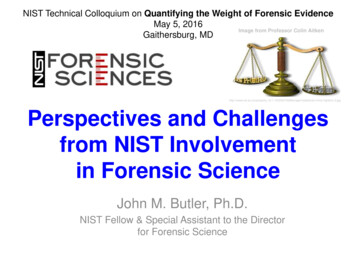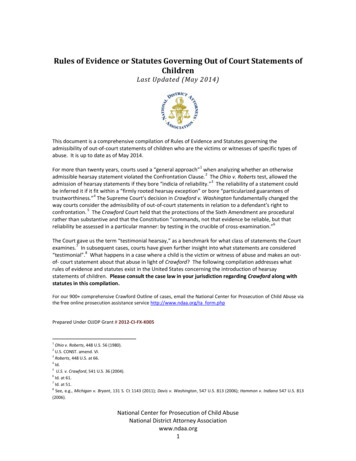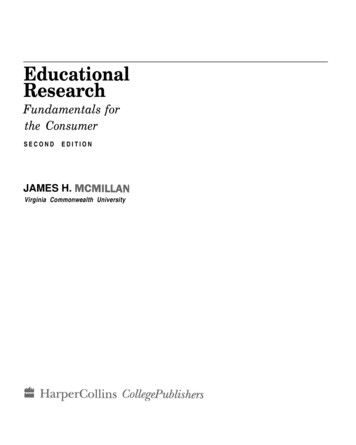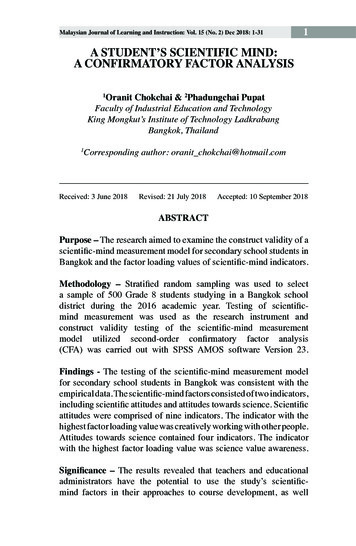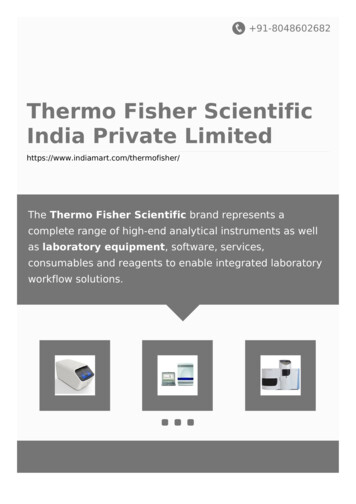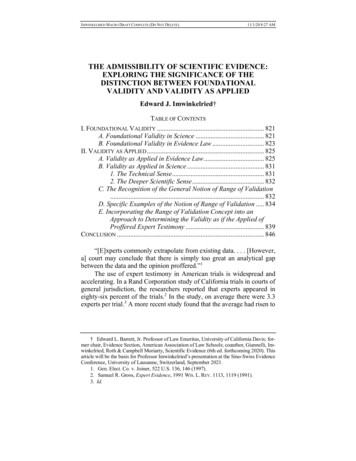
Transcription
IMWINKELRIED MACRO DRAFT COMPLETE (DO NOT DELETE)11/1/20 8:27 AMTHE ADMISSIBILITY OF SCIENTIFIC EVIDENCE:EXPLORING THE SIGNIFICANCE OF THEDISTINCTION BETWEEN FOUNDATIONALVALIDITY AND VALIDITY AS APPLIEDEdward J. Imwinkelried†TABLE OF CONTENTSI. FOUNDATIONAL VALIDITY . 821A. Foundational Validity in Science . 821B. Foundational Validity in Evidence Law . 823II. VALIDITY AS APPLIED . 825A. Validity as Applied in Evidence Law . 825B. Validity as Applied in Science . 8311. The Technical Sense . 8312. The Deeper Scientific Sense . 832C. The Recognition of the General Notion of Range of Validation. 832D. Specific Examples of the Notion of Range of Validation . 834E. Incorporating the Range of Validation Concept into anApproach to Determining the Validity as if the Applied ofProffered Expert Testimony . 839CONCLUSION . 846“[E]xperts commonly extrapolate from existing data. . . . [However,a] court may conclude that there is simply too great an analytical gapbetween the data and the opinion proffered.”1The use of expert testimony in American trials is widespread andaccelerating. In a Rand Corporation study of California trials in courts ofgeneral jurisdiction, the researchers reported that experts appeared ineighty-six percent of the trials.2 In the study, on average there were 3.3experts per trial.3 A more recent study found that the average had risen to† Edward L. Barrett, Jr. Professor of Law Emeritus, University of California Davis; former chair, Evidence Section, American Association of Law Schools; coauthor, Giannelli, Imwinkelried, Roth & Campbell Moriarty, Scientific Evidence (6th ed. forthcoming 2020). Thisarticle will be the basis for Professor Imwinkelried’s presentation at the Sino-Swiss EvidenceConference, University of Lausanne, Switzerland, September 2021.1. Gen. Elect. Co. v. Joiner, 522 U.S. 136, 146 (1997).2. Samuel R. Gross, Expert Evidence, 1991 WIS. L. REV. 1113, 1119 (1991).3. Id.
IMWINKELRIED MACRO DRAFT COMPLETE (DO NOT DELETE)818Syracuse Law Review11/1/20 8:27 AM[Vol. 70:8174.31 experts per trial.4 One commentator has asserted—with only slighthyperbole—that in the United States, trial by jury is evolving into trial byexpert.5Understandably, American courts and evidence commentators havedevoted an enormous amount of attention to the legal standard governingthe admissibility of scientific testimony. Until the mid 1970s, most American jurisdictions followed the standard announced in 1923 in Frye v.United States.6 Under that traditional standard, a scientific methodology,that is, a theory or technique, could serve as a basis for admissible testimony only if its proponent could show that the methodology had gainedgeneral acceptance within the relevant scientific circles.7 However, in1975, the Federal Rules of Evidence took effect.8 The Rules made nomention of the general acceptance test.9 In a line of cases, includingDaubert v. Merrell Dow Pharmaceuticals, Inc. (1993),10 General ElectricCo. v. Joiner (1997),11 Kumho Tire Co., Ltd. v. Carmichael (1999),12 andWeisgram v. Marley Co. (2000),13 the Supreme Court abandoned the Fryetest and substituted an empirical validation/reliability standard derivedfrom the text of Federal Rule 702.14 In pertinent part, the current versionof Rule 702 reads:A witness who is qualified as an expert by knowledge, skill, training, oreducation may testify in the form of an opinion or otherwise if:the expert’s scientific, technical, or other specialized knowledge willhelp the trier of fact to understand the evidence or to determine a fact inissue;(b) the testimony is the product of reliable principles and methods; and4. RONALD J. ALLEN, RICHARD. B. KUHNS, ELEANOR SWIFT, DAVID S. SCHWARTZ, &MICHAEL S. PARDO, EVIDENCE: TEXT, CASES AND PROBLEMS 649 (5th ed. 2011).5. William T. Pizzi, Expert Testimony in the US, 145 N.L.J. 82 (1995).6. 293 F. 1013 (D.C. Ct. Apps. 1923).7. Id.8. See Public Law No. 93-595.9. See Joseph R. Meaney, From Frye to Daubert: Is a Pattern Unfolding?, 35JURIMETRICS, 191, 191 (1995) (“[T]he text of Federal (or Uniform) Rule of Evidence 702 onexpert testimony does not explicitly mention Frye.”).10. 509 U.S. 579 (1993).11. 522 U.S. 136 (1997).12. 526 U.S. 137 (1999).13. 528 U.S. 440 (2000).14. See generally 2 FEDERAL EVIDENCE TACTICS § 7.02 (2019) (explaining that the Courtnow views Federal Rule 702(a) as creating an empirical testing and validation method thatapplies to both controlled empirical testing and other primary methods of validating experttestimony after Daubert and Kumho). See Daubert, 509 U.S. at 582; see also Gen. Elec. Co.,522 U.S. at 142.
IMWWINKELREID MACRO DRAFT COMPLETE (DO NOT DELETE)2020]11/1/20 8:27 AMThe Admissibility of Scientific Evidence819(c) the expert has reliably applied the principles and methods to the factsof the case.15In Daubert, the Court explained that the statutory reference to “scientific knowledge” requires that the proponent present enough empiricaldata and reasoning to persuade the trial judge that the expert’s methodology is reliable in the sense that it is “supported by appropriate [scientific]validation.”16 A 2000 amendment to Rule 702 imposed the additional requirement that the proponent demonstrate that the expert “reliably applied” the methodology to the specific facts of the instant case.17In 2016, the President’s Council of Advisors on Science and Technology (PCAST) released a highly publicized report entitled ForensicScience in Criminal Courts: Ensuring Scientific Validity of FeatureComparison Methods.18 Chapter three of the report is devoted to “TheRole of Scientific Validity in the Courts.”19 The chapter distinguishes between “foundational validity” and “validity as applied.”20 Foundationalvalidity corresponds to Rule 702(a)’s requirement that the proponent establish the general reliability of the expert’s methodology, while validityas applied is equivalent to Rule 702(d)’s mandate that the proponentdemonstrate that the expert has properly applied the methodology in thepending case.21 Like the 2000 amendment to Rule 702, the PCAST reporthighlighted the distinction between the question of the general reliabilityof an expert methodology and the propriety of its application in the pending case.22 That distinction is an important one; in many of the studies offorensic laboratory performance, researchers have found that althoughthe expert employed a trustworthy methodology, the expert erred becausehe or she misapplied the methodology.2315. FED. R. EVID. 702.16. Daubert, 509 U.S. at 590.17. FED. R. EVID. 702, Adv. Comm. Note 2000 Amend.18. PRESIDENT’S COUNCIL OF ADVISORS ON SCIENCE AND TECHNOLOGY, EXEC. OFFICE OFTHE PRESIDENT, FORENSIC SCIENCE IN CRIMINAL COURTS: ENSURING SCIENTIFIC VALIDITY OFFEATURE COMPARISON METHODS (2016) [hereinafter PCAST].19. See id. at 40.20. See id. at 43.21. Eric S. Lander, Fixing Rule 702: The PCAST Report and Steps to Ensure the Reliability of Forensic Feature-Comparison Methods in the Criminal Court, 86 FORDHAM L. REV.1661, 1664–65 (2018). Professor Lander was the Co-Chair of PCAST at the time it preparedthe 2016 report. See PCAST, supra note 18, at 43.22. See Lander, supra note 21; see also PCAST, supra note 18, at 43.23. Edward J. Imwinkelried, The Debate in the DNA Cases Over the Foundation for theAdmission of Scientific Evidence: The Importance of Human Error as a Cause of ForensicMisanalysis, 69 WASH. U. L. REV. 19, 26, 32 (1991) [hereinafter Imwinkelried, Debate].
IMWINKELRIED MACRO DRAFT COMPLETE (DO NOT DELETE)820Syracuse Law Review11/1/20 8:27 AM[Vol. 70:817The thesis of this article is that in order to correctly enforce the distinct requirement for proof of validity as applied, courts need to morecarefully examine the parameters of the validation studies used to establish the general foundational validity of an expert methodology. In particular, the courts must determine the methodology’s extent or range ofvalidation demonstrated in those studies and should find validity as applied lacking when the proponent’s expert attempts to employ the methodology in a fact situation exceeding that range. To develop that thesis,the article proceeds in two parts. The first part of this article discussesfoundational validity. Initially, this part describes the concept from a scientific perspective. The part then demonstrates that the courts have incorporated the concept of foundational validity into their admissibility analysis.Part two turns to the principal focus of this article, namely, validityas applied. Just as part one examines foundational validity from both thescientific and legal viewpoints, part two adopts the same approach to validity as applied. To begin with, part two demonstrates that the cases andcourt rules differentiate between the concepts of foundational validity andvalidity as applied. Part two then demonstrates that the validity as appliedconcept is deeply embedded in scientific reasoning, especially in metrology, the science of measurement. Next, part two notes the striking analogy between a judicial determination of whether to extend a commonlaw precedent to a new fact situation and a judicial decision whether topermit an expert to apply a methodology to a fact situation beyond theprecise parameters of the validation studies. Part two elaborates on thepractical challenge facing a judge required to make the latter decision.Part two argues that if the judge lacks the information necessary to evaluate the propriety of an expert extrapolation, the outcome should be theexclusion of the testimony about the extrapolation. The judge should assign the proponent of the extrapolation the burden of proof on the defensibility of the extrapolation.The conclusion argues that in order to properly enforce the validityas applied requirement in the future, the courts must scrutinize validationstudies far more closely than most courts have done in the past. The courtsmust move beyond a fixation with the quantitative aspects of validationstudies and expand their focus to include the qualitative aspects of thestudies, that is, the conditions under which the methodology was validated. The courts can give the proponent of an extrapolation a powerfulincentive to provide the trial judge with the information needed to makeinformed rulings on the validity as applied issue by making it crystal clearthat the proponent has the burden of establishing an empirical justification warranting any application of the methodology that seemingly
IMWWINKELREID MACRO DRAFT COMPLETE (DO NOT DELETE)2020]The Admissibility of Scientific Evidence11/1/20 8:27 AM821exceeds the demonstrated range of validation. The Supreme Court’sforceful language in Joiner and the explicit prescription in Federal Rule702(d) demand nothing less.24I. FOUNDATIONAL VALIDITYA. Foundational Validity in ScienceChapter 3 of the PCAST Report contains a lucid explanation of theconcept of foundational validity.25 Suppose that a researcher wants to investigate the hypothesis that a particular expert technique or theory isvalid. In order to falsify or validate the hypothesis, the researcher canemploy the “method . . . that has characterized the natural sciences sincethe 17th century, consisting in systematic observation, measurement, andexperimentation, and the formulation, testing, and modification of hypotheses.”26 In other words, the researcher conducts a particular type ofexperiment, namely, an empirical validation study.27 In Daubert, JusticeBlackmun commented that “a key question” in assessing the sufficiencyof the proponent’s showing of reliability is whether the proponent’s hypothesis “has been . . . tested.”28 When the hypothesis is the validity ofan expert methodology, the test takes the form of a validation study.29The PCAST Report emphatically states that extensive experience with atechnique by forensic practitioners is no substitute for such validation;30“[f]oundational validity is a sine qua non, which can only be shownthrough empirical studies.”31In designing the validation study, the researcher controls certain variables and investigates to determine whether, by controlling those variables, he or she can make an accurate prediction of the outcome of theexperiment.32 In the final analysis, the hypothesis is a conditional24. See 522 U.S. 136 at 146–47; see also FED. R. EVID. 702(d).25. PCAST, supra note 18, at 43. PCAST defines scientific standards under the legalstandards in Rule 702(c) and 702(d). Id. PCAST defines “foundational validity” as “the scientific standard corresponding to the legal standard of evidence being based on ‘reliable principles and methods.’” Id.26. Id. at 46 n.101 (quoting Scientific method, OXFORD DICTIONARY (2d ed. 2016)).27. Id. at 46, 52.28. Daubert, 509 U.S. at 593.29. See id. at 590 (finding that in order to qualify as “scientific knowledge” an inferencemust be derived by the scientific method. The proposed testimony must by supported by appropriate validation of the expert’s methodology to meet the requirement and establish astandard of evidentiary reliability).30. PCAST, supra note 18, at 6, 55.31. Id. at 66.32. See id. at 65–66.
IMWINKELRIED MACRO DRAFT COMPLETE (DO NOT DELETE)822Syracuse Law Review11/1/20 8:27 AM[Vol. 70:817proposition: If conditions A, B, and C are controlled, then what is likelyto be the nature of outcome D?33 In evaluating the accuracy of the methodology,34 the researcher attempts to assess both the specificity and thesensitivity of the methodology.35—How specific is the technique? In what percentage of cases in whichthe methodology predicts a positive outcome or conclusion (for example, that the sample is a specific contraband drug), does the methodology lead to an erroneous conclusion (a false positive or Type I error)?—And how sensitive is the technique? In what percentage of cases inwhich the methodology predicts a negative outcome or conclusion (forinstance, that the sample is not a specific drug), does the methodologyyield the converse type of error (a false negative or Type II error)?Of course, to make reliable assessments, the researcher must knowthe ground truth.36 Thus, if the hypothesis relates to the accuracy of ameasuring device, the researcher can use certified reference material(RM) supplied by a national or international metrological authority suchas the National Institute of Standards and Technology (NIST).37Again, the hypothesis is a conditional proposition.38 The researchermust try to validate the methodology for its intended use.39 Thus, as ageneralization if the researcher is endeavoring to validate the use of themethodology for forensic casework, he or she ought to control the variables by specifying conditions that are representative of real world cases.40In the words of a 1979 National Academy of Sciences report on the soundspectrography technique for identifying voices, the study must explorethe validity of the methodology “over the range of conditions usually metin practice.”41 The PCAST Report uses fingerprint examination as a further illustration of the point.42 In real life casework, fingerprint examinersroutinely encounter low quality latent prints, that is, prints that are both33. See Edward J. Imwinkelried, Coming to Grips with Scientific Research in Daubert’s“Brave New World”: The Courts’ Need to Appreciate the Evidentiary Difference BetweenValidity and Proficiency Studies, 61 BROOK. L REV. 1247, 1258 (1995).34. See id. at 47–48.35. Id. at 50.36. See William A. Woodruff, Evidence of Lies and Rules of Evidence: The Admissibilityof fMRI-Based Expert Opinion of Witness Truthfulness, 16 N.C. J.L. & TECH. 105, 223 (2014).37. TED VOSK, FORENSIC METROLOGY: SCIENTIFIC MEASUREMENT AND INFERENCE FORLAWYERS, JUDGES, AND CRIMINALISTS 81–82 (1st ed. 2014).38. See PCAST, supra note 18, at 60; see also supra text accompanying note 33.39. Id. at 46.40. Id. at 48, 52, 66.41. NATIONAL ACADEMY OF SCIENCES, ON THE THEORY AND PRACTICE OF VOICEIDENTIFICATION 58 (1979).42. See PCAST, supra note 18, at 52, 149.
IMWWINKELREID MACRO DRAFT COMPLETE (DO NOT DELETE)2020]11/1/20 8:27 AMThe Admissibility of Scientific Evidence823partial and distorted.43 Even if an experiment involving a fingerprint technique produced an impressive accuracy rating, the experiment would furnish little validation for the forensic application of the technique if thefinger marks in the study were complete and high-quality, fully scannedprints.44B. Foundational Validity in Evidence LawPrior to Daubert, the courts were often content to rely on proxiesrather than directly addressing the question of the empirical validity of anexpert technique.45 By way of example, instead of reviewing the empirical data in the relevant validation studies, under Frye a court confined itsinquiry to how well accepted or popular a methodology was within therelevant scientific circles.46 The appellate courts precluded trial judgesfrom scrutinizing the empirical data underlying the methodology in parton the assumption that trial judges lacked the competence to criticallyevaluate the validation studies.47In this respect, Daubert works a sea change in Evidence law.48 PostDaubert, trial judges may no longer “[hide] from science.”49 Dauberttasks trial judges to determine whether the methodology underlying proffered expert testimony is reliable in the classic scientific sense:“Science is not an encyclopedic body of knowledge about the universe.Instead, it represents a process for proposing and refining theoreticalexplanations about the world that are subject to further testing and refinement.” [I]n order to qualify as “scientific knowledge” [within theintendment of that expression in Rule 702], an inference or assertionmust be derived by the scientific method. Proposed testimony must besupported by appropriate validation—i.e., “good grounds,” based onwhat is known. In short, the requirement that an expert’s testimony43. Id. at 52.44. Id.45. Bert Black, Francisco J. Ayala & Carol Saffran-Brinks, Science and the Law in theWake of Daubert: A New Search for Scientific Knowledge, 72 TEX. L. REV. 715, 723–24(1994).46. Id. at 725.47. 1 PAUL C. GIANNELLI, EDWARD J. IMWINKELRIED, ANDREA ROTH & JANE CAMPBELLMORIARTY, SCIENTIFIC EVIDENCE § 1.06(a) (5th ed. 2012).48. See Black, Ayala & Saffran-Brinks, supra note 45, at 722 (“The analysis used by preDaubert courts that applied the Rules in lieu of Frye typically involves balancing variousenumerated factors, albeit without any guidance on how the factors relate to each other orhow they fit into a coherent picture of the way science actually works.”); but see FED. R. EVID.702, Adv. Comm. Note 2000 Amend. (commenting that Daubert did not work a “seachangeover federal evidence law,” and that caselaw shows that courts do not commonly reject experttestimony despite the courts’ gatekeeper role post-Daubert).49. Black, Ayala & Saffran-Brinks, supra note 45, at 722.
IMWINKELRIED MACRO DRAFT COMPLETE (DO NOT DELETE)824Syracuse Law Review11/1/20 8:27 AM[Vol. 70:817pertain to “scientific knowledge” establishes a standard of evidentiaryreliability.50Justice Blackmun continued:Faced with a proffer of expert scientific testimony, the trial judge must. . . [make] a preliminary assessment of whether the reasoning or methodology underlying the testimony is scientifically valid. “Scientificmethodology today is based on generating hypotheses and testing themto see if they can be falsified . . . .”51In the macrocosm, society places faith in science because that is an“immense body” of empirical data demonstrating the successful “results”of applying scientific methodology.52 Daubert prescribed that in the microcosm of deciding whether to admit testimony about a specific scientific methodology, the judge should similarly focus on the results in theempirical data.53Perhaps the best synthesis of Daubert line of authority’s pronouncements on foundational validity is that the expert must marshal enoughempirical data and reasoning to convince the trial judge that by employing the particular methodology that he or she proposes relying on, theexpert can accurately draw the specific type of inference that the expertcontemplates testifying to.54 The judge’s analytic focus should be on theexpert’s particular methodology, not the global validity of the expert’sdiscipline.55 Furthermore, as the Advisory Committee Note to the 2000amendment to Rule 702 emphasizes, out of respect for the jury’s role, thejudge does not pass on the question of whether the specific opinion drawn50. Daubert v. Merrell Dow Pharm., Inc., 509 U.S. 579, 590 (1993).51. Id. at 592–93.52. See JOHN ZIMAN, RELIABLE KNOWLEDGE: AN EXPLORATION OF THE GROUNDS FORBELIEF IN SCIENCE 6–7, 127 (1978).53. See Daubert, 509 U.S. at 593.54. Edward J. Imwinkelried, The Best Insurance Against Miscarriages of Justice Causedby Junk Science: An Admissibility Test that Is Scientifically and Legally Sound, 81 ALB. L.REV. 851, 857 (2017/2018) [hereinafter Imwinkelried, Insurance].55. D. Michael Risinger, Defining the “Task at Hand”: Non-Science Forensic ScienceAfter Kumho Tire Co. v. Carmichael, 57 WASH. & LEE L. REV. 767, 769–70, 772, 774, 798(2000). In Kumho, the Court made it clear that the trial judge must conduct a “very particularanalysis” of the expert’s ability to perform the specific task at hand. Id. at 774 (citing Kumho,526 U.S. at 141). In United States v. Fujii, the court balked at issuing a sweeping rule on theglobal validity of questioned document examination; however, the court refused to admit aQD examiner’s testimony purportedly identifying the author of a document composed in Japanese handprinting; the testimony in the record indicated that when persons are taught thatstyle of handprinting, they are encouraged to suppress individual characteristics and preciselyreproduce the figure. See 152 F. Supp. 2d 939, 940, 941 (N.D. Ill. 2000).
IMWWINKELREID MACRO DRAFT COMPLETE (DO NOT DELETE)2020]The Admissibility of Scientific Evidence11/1/20 8:27 AM825by the expert is correct;56 rather, the judge’s limited role is to review theempirical data to determine whether they establish the expert’s ability todraw the type or kind of inference he or she proposes testifying to, suchas an inference as to a person’s credibility or a disputed fact on the historical merits.57II. VALIDITY AS APPLIEDIn the typical case, the litigants are not concerned only about thegeneral or foundational validity of an expert methodology.58 The litigantsare also concerned about the procedures actually applied in the case andwhether the application was proper.59 As previously stated, the 2000amendment to Rule 702 added an express requirement that the proponentshow that the expert properly applied the methodology to the facts of theinstant case.60 The amendment reflects the elementary insight that as amatter of logic, validity as applied is just as essential to the reliability ofthe testimony proffered as foundational validity.61A. Validity as Applied in Evidence LawAlthough most of the early commentary on the 1993 Daubert decision focused on the new empirical standard for foundational validity announced in that case, the Daubert opinion itself included references to theconcept of validity as applied.62 Justice Blackmun wrote that the trialjudge must determine whether the “methodology properly can be applied56. FED. R. EVID. 702, Adv. Comm. Note 2000 Amend. (the trial judge does not apply“the merits standard of [the] correctness” of the opinion).57. Imwinkelried, Insurance, supra note 54, at 866–69. In the original Daubert opinion,Justice Blackmun had cautioned that “[t]he focus . . . must be solely on principles and methodology, not on the conclusions that they generate.” 509 U.S. at 595.58. PCAST, supra note 18, at 56 (describing foundational validity as a method that canbe reliable in principle, compared to validity as applied as a method that has been reliablyapplied in practice).59. Id. at 56, 66.60. FED. R. EVID. 702, Adv. Comm. Note 2000 Amend. The amendment specifically provides that the trial court must scrutinize not only the principles and methods used by the expert, but also whether those principles and methods have been properly applied to the facts ofthe case.”). See United States v. Gomez-Paz et al., 2011 U.S. Dist. LEXIS 105442, 2011 WL4345891 (D. Colo. Sept. 16, 2011) (although the court found that the prosecution’s foundation“squeaks by” under Rule 702, the court stressed that the proponent must show the “reliableapplication” of the expert’s methodology).61. See FED. R. EVID. 702, Adv. Comm. Note 2000 Amend. (stating that trial courts mustuse Daubert factors to assess the reliability and helpfulness of proffered expert testimony).62. See Daubert, 509 U.S. at 593.
IMWINKELRIED MACRO DRAFT COMPLETE (DO NOT DELETE)826Syracuse Law Review11/1/20 8:27 AM[Vol. 70:817to the facts in issue.”63 He stated that the methodology must “fit” the“facts of the case”64 and be relevant to the specific “task at hand.”65As time passed, the need for a showing of validity as applied becameeven clearer.66 A case in point is the Supreme Court’s 1997 decision inGeneral Electric Co. v. Joiner.67 There the plaintiffs endeavored to establish that their exposure to polychlorinated biphenyls (PCBs) at the defendant’s plant caused Mr. Joiner’s lung cancer.68 The plaintiffs reliedheavily on animal studies to prove causation.69 However, there weremarked differences between the parameters of the studies and the facts ofthe instant case.70 Chief Justice Rehnquist wrote:The [animal] studies involved infant mice that had developed cancerafter being exposed to PCBs. The infant mice in the studies had hadmassive doses of PCBs injected directly into their peritoneums or stomachs. Joiner was an adult human being whose alleged exposure to PCBswas far less than the exposure in the animal studies. The PCBs wereinjected into the mice in a highly concentrated form. The fluid withwhich Joiner had come into contact generally had a much smaller PCBconcentration of between 0-500 parts per million. The cancer that thesemice developed was alveologenic adenomas; Joiner had developedsmall-cell carcinomas.71The Court did not deny that the studies supported the hypothesis thatmassive direct injections of PCBs into certain organs of infant mice cancause certain types of cancer.72 However, the dispositive question inJoiner was whether those studies provided sufficient empirical supportfor an inference of causation in human beings under different conditions.73 The Court stressed that the parameters of the studies were “sodissimilar to the facts presented in this litigation . . . .”74 The Court thenaddressed the broader question of validity as applied:Trained experts commonly extrapolate from existing data. But nothingin either Daubert or the Federal Rules of Evidence requires a district63. Id.64. Id. at 591; see Harris v. Remington Arms Co., 398 F. Supp. 3d 1126, 1130 (W.D.Okla. 2019).65. Daubert, 509 U.S. at 597.66. See Gen. Elec. Co. v. Joiner, 522 U.S. 136, 146 (1997).67. Id.68. Id. at 139–40, 143.69. Id. at 143.70. See id. at 144.71. Joiner, 522 U.S. at 144.72. See id.73. See id.74. Id.
IMWWINKELREID MACRO DRAFT COMPLETE (DO NOT DELETE)2020]11/1/20 8:27 AMThe Admissibility of Scientific Evidence827court to admit opinion evidence that is connected to existing data onlyby the ipse dixit of the expert. A court may conclude that there is simplytoo great an analytical gap between the data and the opinion proffered.75Three years later in 2000, Rule 702 was amended to explicitly impose a requirement for a showing of validity as applied.76 As restyled in2011, Rule 702(c) mandates a showing of foundational validity: the proponent must show that “the testimony is the product of reliable principlesand methods.”77 The very next subsection, 702(d), now provides that theproponent must also establish that “the expert has reliably applied theprinciples and methods to the facts of the case.”78 The accompanying Advisory Committee Note echoes the pertinent passages in Daubert andJoiner; the Note mentions the need for “fit” and observes that the trialjudge must inquire whether the expert has “unjustifiably extrapolated.”79The Note flatly asserts that the judge must find that the methodology has“been properly applied to the facts of the case” and that a “misappli[cation]” can render the expert’s testimony unreliable and inadmissible.80The jurisprudence in the lower courts is mixed.81 Some courts arecontent to reiterate the generalization that the proponent must establishthat the expert has properly applied the methodology to the facts of thepending case.82 Other courts tend to focus on the quantitative aspects of75. Id. at 146.76. FED R. EVID. 702, Adv. Comm. Note 2000 Amend.77. Id. 702(c).78. Id. See United States v. Gomez-Paz et al., 2011 U.S. Dist. LEXIS 105442, 2011 WL4345891 (D. Colo. Sept. 16, 2011) (“reliable application”).79. FED. R. EVID. 702, Adv. Comm. Note 2000 Amend.80. Id.81. See infra notes 82–85.82. Johnson v. Arkema, Inc., 685 F.3d 452, 459 (5th Cir. 2012); Benton v. Deli Mgmt.,396 F. Supp. 3d 1261, 1280 (N.D. Ga. 2019).
IMWINKELRIED MACRO DRAFT COMPLETE (DO NOT DELETE)828Syracuse Law Review11/1/20 8:27 AM[Vol. 70:817the validation studies.83 For example, they stress the size of the study84 orthe error rate reported in the study.85The opinions described in the preceding paragraph make short shriftof
In 2016, the President's Council of Advisors on Science and Tech-nology (PCAST) released a highly publicized report entitled Forensic Science in Criminal Courts: Ensuring Scientific Validity of Feature-Comparison Methods.18 Chapter three of the report is devoted to "The Role of Scientific Validity in the Courts."19 The chapter .




